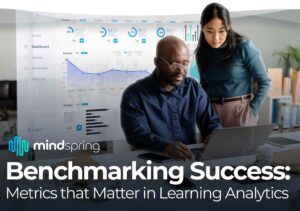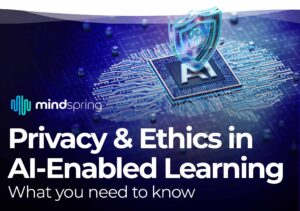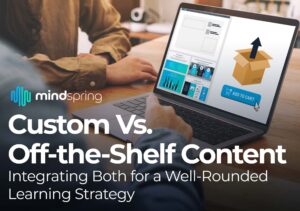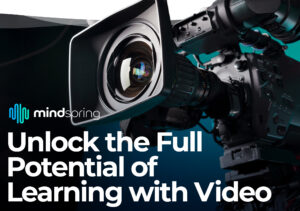Story Introduction
Kathryn is the Chief Learning Officer at a fictional manufacturing company called AshCom, located in Minneapolis. Kathryn has been the CLO for more than five years and, with her team, has produced some amazing learning experiences. But things are changing fast. Rebecca is a consultant from MindSpring who has served as an advisor to Kathryn for the last four years. This is their story.
Kathryn and Rebecca sat at the conference table in Kathryn’s office. On the whiteboard was a list of eleven questions written by Rebecca, who promised they would clarify some of the challenges Kathryn faced.
AshCom’s learning challenges were significant and began with a decline in training results. Learners were learning less and making fewer behavioral adjustments in their daily work. Fewer people were seeking out learning opportunities. Something in the culture was changing.
Just as Kathryn and her learning team began to notice these shifts, the Chief Financial Officer announced a hiring freeze for every division in the 7,000-person company. That news unsettled her team. Two weeks later, the youngest member of Kathryn’s team announced she was leaving.
AshCom’s financial performance had been a struggle, and now it deepened. The CFO told Kathryn that she needed to make reductions. She had to let two people go. In a short period of time, her team had gone from ten very capable people who functioned well as a group to seven people who were unsure of what the future might hold for them.
Kathryn called in Rebecca to help, and she immediately got to work. She introduced eleven questions that would help Kathryn find clarity and build a pathway for moving forward.
Their focus for this session was, “Who are the targeted learners, and how well do you know them?” As they settled into their chairs, Kathryn said, “This is an odd question.” She didn’t intend the statement to be offensive. She was simply trying to understand.
“How so?” asked Rebecca.
Kathryn started slowly. “Well, it occurs to me that none of my team members are new. The seven remaining people on my team have been here a while. One has been here for more than twenty years. I think we know our learners pretty well.”
“Ok,” said Rebecca. “Any other concerns?”
“Yes,” replied Kathryn.
“More than seven thousand people work for AshCom. Our plants are in multiple locations, and each location has a different mix of people. What I’m getting at is, how could we possibly know them all? Is it even possible to answer this question?”
Rebecca smiled. The relationship between them was strong enough for a little good-natured teasing. “Let me get this straight,” Rebecca said. “On the one hand, you told me that your team has been here for a while and knows the learning audience. On the other, you’re asking how you can possibly know all of them. Which is it?
Kathryn didn’t back down. “I know they sound like opposites, but I’m standing by both statements,” she said, returning the smile. “I hadn’t really thought about that before. The truth is I only really know a small percentage of the seven thousand people who work here, and probably fewer than one hundred fairly well.”
“I’d be impressed if you knew one hundred people well, but I understand your point,” said Rebecca. “We work with a lot of very large corporations, and all of them have the same struggle. I’m familiar with the challenge. Most people who have been through this list of eleven questions eventually come to this one and have the same reaction.”
“So what are we really trying to get at with this question?” asked Kathryn. Her response came out more harshly than she intended. She found herself doing that more often since she had to remove two members of her team. The stress was taking a toll.
Rebecca didn’t respond in kind, nor did she harbor any ill feelings. She was often in tense conversations with people who were under pressure. Kathryn’s response wasn’t surprising.
“I’ll get right to it,” said Rebecca. “We’re going to create some personas.”
“Some what?” asked Kathryn.
“Personas,” said Rebecca. “Personas come from the world of sales and marketing. Imagine you’ve been tasked with marketing a new product. You would begin with building personas of your potential customers. There might be a single audience, but chances are there are several audiences.”
"Personas are a way of understanding those audiences by focusing on one representative of each group.”
“You mean learner profiles,” said Kathryn.
“I mean more than that,” responded Rebecca. “If it’s helpful, think of personas as next-level learner profiles. We’ll look beyond education, job roles, and language barriers. The more specific we can get, the better. We want to know what’s going on in the minds, hearts, and lives of your learning audiences. If we know this, we can help you create learning experiences better tailored to AshCom’s learners.
“Got it,” said Kathryn. “And how do we do that?”
“Let’s start by laying out some of the things we’ll want to know,” replied Rebecca. “We’re going to focus on describing a single person rather than a group of people. The persona will be an individual. That is, not every detail we describe about them will apply to everyone in the group. But, at the same time, the persona will represent the general type of people in the group.”
“That’s an interesting approach,” said Kathryn. “We’ve never tried to think about this as a single person. We are usually thinking about group dynamics.”
“I think you’ll find this helpful,” said Rebecca. “We aren’t going to go through the exercise today, but I want to frame it out for you. We need to do some research and think about questions like these.” Rebecca walked to the whiteboard.
She wrote:
- Where does this person get advice?
- Who influences them?
- What’s their personality?
- What is this person passionate about?
- How does this person like to learn?
- What does success look like to them?
- What is frustrating this person right now?
- What are the barriers to this person learning well?
“So,” Rebecca continued, “you and I will use these questions and what you know about a specific group of learners to create a persona. We’ll give the individual a name and even a face. We’ll build their story. Once we’ve done that, we’ll present the persona to members of your learning team and refine it. Then we’ll ask a leader in this group of learners to see if we’re on target.”
“Let’s call him Kevin. That was my dad’s name. But how does this help my team?” asked Kathryn.
“Kevin works just fine, but we’ll revisit that once we’re aligned,” responded Rebecca. “Kevin—the persona—will help your team connect with the people they’re designing for. We’ll create a list of challenges learning can solve for Kevin or opportunities he’ll gain. We’ll learn about gaps in Kevin’s training. We’ll think about Kevin in everything your team builds. I’ve even seen learning experience designers hang a picture of the persona they’re working on in their cubicles.”
“I get it,” said Kathryn. “I’ve actually done something like this when I’ve been asked to give speeches. When I’m preparing I try to think of a specific person and what that person needs to hear that day. It helps me focus. How do we begin to gather information?”
“I’m sure you’ll need to engage with someone from your human resources department,” replied Rebecca. “They’ll already have some demographic categories. They can also give us data about your target learners’ experience level, their education, and so forth. But that’s only the beginning. The real work starts once you have that information.”
“That’s a great place to begin. I see what you’re getting at, but can I take us in a slightly different direction?” asked Kathryn. Without waiting for a response, she continued, “Diversity, equity, and inclusion have become important initiatives at AshCom. Our C-Suite has given several tasks to human resources to strengthen our performance as a diverse, equitable, and inclusive culture. Our learning team has been discussing how learning can support these efforts.”
“Interesting segue,” said Rebecca. “You picked the name ‘Kevin,’ a name that makes you think of someone specific. Your dad, right? As a result, you probably make some assumptions about race, gender, and age when you think of that persona. This needs some thought. Who would see themselves in this persona and who wouldn’t?”
“Point taken. But this goes beyond the personas,” said Kathryn. “I’m afraid a lot of people can’t see or hear themselves in the learning experience we’re creating, and going through the persona exercise will make some of our assumptions obvious.”
“It certainly will,” said Rebecca, “because at some point, you’ll have to make choices. This exercise isn’t easy, but it’s very good. When I’m thinking about my learners and how they’re represented in our learning materials, I often reference this rubric that shows ways to create diversity, equity, inclusion, and justice ‘lenses.’ I’ve found it really helpful when thinking through these issues.
“That’s where we need to land,” said Kathryn. “We need to get to a better place as a learning team and as a company.”
After a few seconds of silence, Kathryn said, “This question is a lot harder than I thought. Let’s take a break and tackle the next one.”
Glancing up at the white board, Kathryn read out loud,
Do your learners care about learning, and how does learning connect with their goals?”
She continued, “Seriously? Didn’t we just cover that?”
“Learner profiles and personas are a necessary step,” replied Kathryn. “What we did in this session is to simply seek a better understanding of your learners. Whether or not your learners care about learning is a much broader discussion that goes beyond who they are. It will zero in on AshCom’s learning culture and culture in general.”
“So this isn’t going to get easier?” asked Kathryn.
“I didn’t promise easy,” said Rebecca. “I can only promise that we’ll go deeper into our understanding of learning at AshCom.”
“That’s what I asked for,” replied Kathryn. “I’m getting what I paid for.”
“I certainly hope so,” said Rebecca. “Let’s take a break and move forward. Are you ok with that?”
“I am,” said Kathryn. “Let’s move forward.”
Interested in learning more from our thought leaders perspective?
Related Articles
Article 3: Who are the targeted learners and how well do you know them?
Article 4: Do your learners care about learning and how does learning connect with their goals?
Article 5: What organizational factors are influencing your learning initiatives?
Article 6: How will get your learners’ attention and build momentum for learning?
Article 8: How are you measuring the impact of learning on your organization?
Article 9: How are you keeping current or ahead of the curve in the learning industry?
Article 10: How are you upskilling your learning team?
Article 11: How will you meet your objectives without adding full-time team members?
Article 12: What is your 3–5-year plan for learning in your company?









